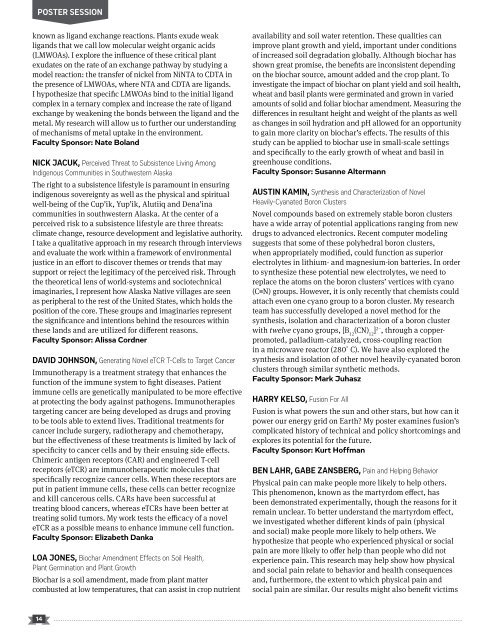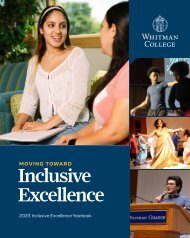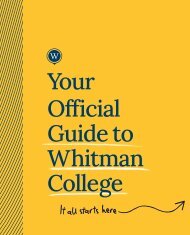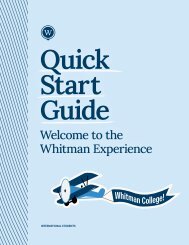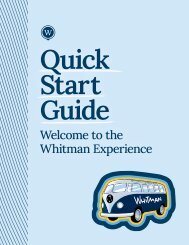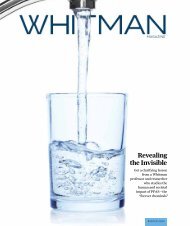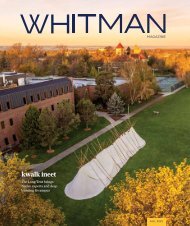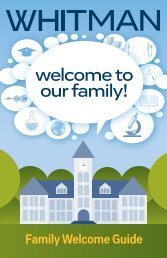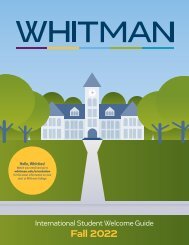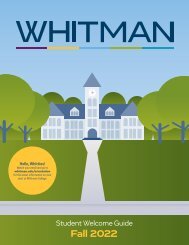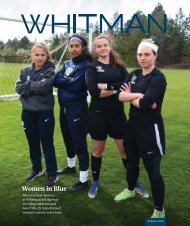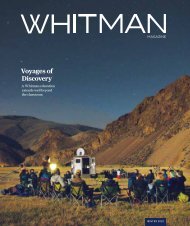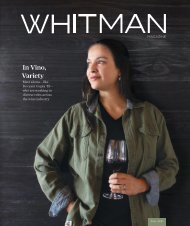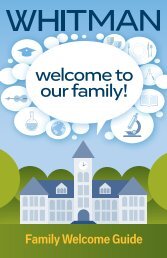Whitman College Undergraduate Conference Program 2020
Whitman College 2020 Undergraduate Conference Program
Whitman College 2020 Undergraduate Conference Program
You also want an ePaper? Increase the reach of your titles
YUMPU automatically turns print PDFs into web optimized ePapers that Google loves.
POSTER SESSION<br />
known as ligand exchange reactions. Plants exude weak<br />
ligands that we call low molecular weight organic acids<br />
(LMWOAs). I explore the influence of these critical plant<br />
exudates on the rate of an exchange pathway by studying a<br />
model reaction: the transfer of nickel from NiNTA to CDTA in<br />
the presence of LMWOAs, where NTA and CDTA are ligands.<br />
I hypothesize that specific LMWOAs bind to the initial ligand<br />
complex in a ternary complex and increase the rate of ligand<br />
exchange by weakening the bonds between the ligand and the<br />
metal. My research will allow us to further our understanding<br />
of mechanisms of metal uptake in the environment.<br />
Faculty Sponsor: Nate Boland<br />
NICK JACUK, Perceived Threat to Subsistence Living Among<br />
Indigenous Communities in Southwestern Alaska<br />
The right to a subsistence lifestyle is paramount in ensuring<br />
indigenous sovereignty as well as the physical and spiritual<br />
well-being of the Cup’ik, Yup’ik, Alutiiq and Dena’ina<br />
communities in southwestern Alaska. At the center of a<br />
perceived risk to a subsistence lifestyle are three threats:<br />
climate change, resource development and legislative authority.<br />
I take a qualitative approach in my research through interviews<br />
and evaluate the work within a framework of environmental<br />
justice in an effort to discover themes or trends that may<br />
support or reject the legitimacy of the perceived risk. Through<br />
the theoretical lens of world-systems and sociotechnical<br />
imaginaries, I represent how Alaska Native villages are seen<br />
as peripheral to the rest of the United States, which holds the<br />
position of the core. These groups and imaginaries represent<br />
the significance and intentions behind the resources within<br />
these lands and are utilized for different reasons.<br />
Faculty Sponsor: Alissa Cordner<br />
DAVID JOHNSON, Generating Novel eTCR T-Cells to Target Cancer<br />
Immunotherapy is a treatment strategy that enhances the<br />
function of the immune system to fight diseases. Patient<br />
immune cells are genetically manipulated to be more effective<br />
at protecting the body against pathogens. Immunotherapies<br />
targeting cancer are being developed as drugs and proving<br />
to be tools able to extend lives. Traditional treatments for<br />
cancer include surgery, radiotherapy and chemotherapy,<br />
but the effectiveness of these treatments is limited by lack of<br />
specificity to cancer cells and by their ensuing side effects.<br />
Chimeric antigen receptors (CAR) and engineered T-cell<br />
receptors (eTCR) are immunotherapeutic molecules that<br />
specifically recognize cancer cells. When these receptors are<br />
put in patient immune cells, these cells can better recognize<br />
and kill cancerous cells. CARs have been successful at<br />
treating blood cancers, whereas eTCRs have been better at<br />
treating solid tumors. My work tests the efficacy of a novel<br />
eTCR as a possible means to enhance immune cell function.<br />
Faculty Sponsor: Elizabeth Danka<br />
LOA JONES, Biochar Amendment Effects on Soil Health,<br />
Plant Germination and Plant Growth<br />
Biochar is a soil amendment, made from plant matter<br />
combusted at low temperatures, that can assist in crop nutrient<br />
availability and soil water retention. These qualities can<br />
improve plant growth and yield, important under conditions<br />
of increased soil degradation globally. Although biochar has<br />
shown great promise, the benefits are inconsistent depending<br />
on the biochar source, amount added and the crop plant. To<br />
investigate the impact of biochar on plant yield and soil health,<br />
wheat and basil plants were germinated and grown in varied<br />
amounts of solid and foliar biochar amendment. Measuring the<br />
differences in resultant height and weight of the plants as well<br />
as changes in soil hydration and pH allowed for an opportunity<br />
to gain more clarity on biochar’s effects. The results of this<br />
study can be applied to biochar use in small-scale settings<br />
and specifically to the early growth of wheat and basil in<br />
greenhouse conditions.<br />
Faculty Sponsor: Susanne Altermann<br />
AUSTIN KAMIN, Synthesis and Characterization of Novel<br />
Heavily-Cyanated Boron Clusters<br />
Novel compounds based on extremely stable boron clusters<br />
have a wide array of potential applications ranging from new<br />
drugs to advanced electronics. Recent computer modeling<br />
suggests that some of these polyhedral boron clusters,<br />
when appropriately modified, could function as superior<br />
electrolytes in lithium- and magnesium-ion batteries. In order<br />
to synthesize these potential new electrolytes, we need to<br />
replace the atoms on the boron clusters’ vertices with cyano<br />
(C N) groups. However, it is only recently that chemists could<br />
attach even one cyano group to a boron cluster. My research<br />
team has successfully developed a novel method for the<br />
synthesis, isolation and characterization of a boron cluster<br />
with twelve cyano groups, [B 12<br />
(CN) 12<br />
] 2– , through a copperpromoted,<br />
palladium-catalyzed, cross-coupling reaction<br />
in a microwave reactor (280˚ C). We have also explored the<br />
synthesis and isolation of other novel heavily-cyanated boron<br />
clusters through similar synthetic methods.<br />
Faculty Sponsor: Mark Juhasz<br />
HARRY KELSO, Fusion For All<br />
Fusion is what powers the sun and other stars, but how can it<br />
power our energy grid on Earth? My poster examines fusion’s<br />
complicated history of technical and policy shortcomings and<br />
explores its potential for the future.<br />
Faculty Sponsor: Kurt Hoffman<br />
BEN LAHR, GABE ZANSBERG, Pain and Helping Behavior<br />
Physical pain can make people more likely to help others.<br />
This phenomenon, known as the martyrdom effect, has<br />
been demonstrated experimentally, though the reasons for it<br />
remain unclear. To better understand the martyrdom effect,<br />
we investigated whether different kinds of pain (physical<br />
and social) make people more likely to help others. We<br />
hypothesize that people who experienced physical or social<br />
pain are more likely to offer help than people who did not<br />
experience pain. This research may help show how physical<br />
and social pain relate to behavior and health consequences<br />
and, furthermore, the extent to which physical pain and<br />
social pain are similar. Our results might also benefit victims<br />
of physical and psychological trauma and provide insight into<br />
ways to encourage helpfulness toward others.<br />
Faculty Sponsor: Wally Herbranson<br />
KATY LALIOTIS, Observing Qatar-1b Exoplanet Transits<br />
I confirm orbital properties of the exoplanet Qatar-1b and, in<br />
so doing, demonstrate our ability to perform high-precision<br />
transit photometry for moderately bright planetary systems<br />
using a relatively small telescope at a low-elevation observing<br />
site. Qatar-1 is a magnitude 12.8 metal-rich K dwarf star in<br />
the constellation Draco. In 2011, Alsubai et al. announced the<br />
existence of a planet orbiting Qatar-1: Qatar-1b, a “hot Jupiter,”<br />
has a mass slightly larger than that of Jupiter and an orbit<br />
period of 1.42 days. I observed a transit of Qatar-1b on July<br />
26, 2019, using the 0.77-meter Hoch telescope at the Pacific<br />
Northwest Regional Observatory at Wallula Gap, Washington.<br />
Using the AstroImageJ data analysis package, I analyzed<br />
these data together with observations made by colleagues<br />
in March 2019 at Lowell Observatory in Flagstaff, Arizona,<br />
determining a planetary transit duration of 1.675 hours and a<br />
transit depth of 2.4% using the Johnson-Cousins R filter.<br />
Faculty Sponsor: Andrea Dobson<br />
KYLE LEVIN, Conceptions of Time and Social Stratification:<br />
A Phenomenological Approach<br />
Time is a subject on which humans have ruminated for<br />
ages. Yet, not until the past century have sociologists<br />
taken an active interest in time. My study examines the<br />
tensions between the dominant structural view of time<br />
and the everyday micro-expressions of time management. I<br />
investigate the following question: Do conceptions of time<br />
differ in relation to a person’s positionality, specifically,<br />
race, class and gender? My work is sociologically significant<br />
because it explores time not only through the interactions<br />
and consciousness of the individual but also by way<br />
of the influence of a larger structural force: hegemony.<br />
Furthermore, time has rarely been examined in the context<br />
of an individual’s race and gender. I hope that these new<br />
perspectives will contribute to a broader sociological<br />
understanding of time and a consideration of how social<br />
position influences knowledge production.<br />
Faculty Sponsor: Matthew Gougherty<br />
SOPHIE LOVE, Species Richness, Abundance and Trophic Distribution<br />
of Mammals in Tanzania<br />
Worldwide, the interface between humans and wildlife is<br />
increasingly fraught with conflict. The Yaeda Valley of Tanzania<br />
has implemented a multi-zone land-use plan that allocates<br />
different amounts of land for humans and wildlife. My question:<br />
How did the implementation of land-use zones influence species<br />
richness, density and trophic composition of mammals between<br />
2015 and 2018? In order to monitor mammals through both<br />
signs and sightings, multiple 2-kilometer-long transects were<br />
walked in each zone during the short rainy season. I found<br />
mean species richness to be similar between years in all zones,<br />
with the exception of the unmanaged zone. Abundance of<br />
individuals varied widely among species, zones and years.<br />
The percent abundance of all mammals among trophic<br />
levels reflects the theoretical distributions, with the largest<br />
percentage being herbivores. I discuss the implications of<br />
these findings in terms of the land-use plan’s effectiveness and<br />
insights for future wildlife management.<br />
Faculty Sponsor: Heidi Dobson<br />
JESSIE MANO, Influence of Ideal Affect and Group Status on<br />
Leadership Choice<br />
What emotions do Americans look for in leaders and how<br />
does this vary between cultures that possess different<br />
emotional values? Research suggests cultural differences in<br />
“ideal affect” (affective states that people value and want to<br />
feel). European Americans and Asian Americans value excited<br />
states more than calm states compared to Hong Kong Chinese.<br />
The research team I joined at Stanford University expands on<br />
this knowledge to consider preferred emotional expression in<br />
leaders across cultures and whether preferences depend on<br />
how well the group is doing (growth vs. crisis). Three cultural<br />
groups (European Americans, Asian Americans and Hong<br />
Kong Chinese) were examined. Participants read hypothetical<br />
scenarios of businesses experiencing growth or crisis.<br />
Participants selected one of three images, each depicting a<br />
leadership candidate with a distinct emotional expression.<br />
During growth, people chose leaders that reflected their ideal<br />
affect whereas no preference for excited (vs. calm) candidates<br />
was exhibited during crisis.<br />
Faculty Sponsor: Lauren Berger<br />
KAIA MARTIN, Measuring Kinetics of Transition Metal Nanocrystal<br />
Formation Using Coproduct Kinetics<br />
The optoelectronic properties of transition metal nanocrystals<br />
have a wide range of uses in many fields, including green<br />
energy, electronics and medicine. However, the formation<br />
of transition metal-chalcogenide nanocrystals is poorly<br />
understood due to the crystals’ complex electronic structure.<br />
My goal is to measure the kinetics of nanocrystal formation<br />
and to figure out how the kinetics of the reaction influence the<br />
phase of the product. I found that in the conversion of copper<br />
salts and substituted thiourea to copper sulfide nanocrystals,<br />
upon diluting these reactions 1000x the absorbance spectra<br />
show an interconversion between two peaks that may<br />
correspond to a reactant and a non-nanocrystal product.<br />
Current work aims to identify these peaks using nuclear<br />
magnetic resonance spectroscopy. Identifying the peaks has<br />
the potential to expand our understanding of nanocrystal<br />
reaction kinetics, pushing us closer to our goal of controlling<br />
the phase of copper sulfide nanocrystals.<br />
Faculty Sponsor: Mark Hendricks<br />
AUBREY MAY, Characterizing Vine Mealybug Spread in the Napa Valley<br />
The wine industry in the Napa Valley is increasingly<br />
threatened by the vine mealybug (Planococcus ficus). This<br />
mealybug often eludes detection due to its obscured habitat<br />
under the grapevine bark. A habitat suitability model<br />
was constructed using previous mealybug data to predict<br />
mealybug presence and movement throughout the valley.<br />
14 15


